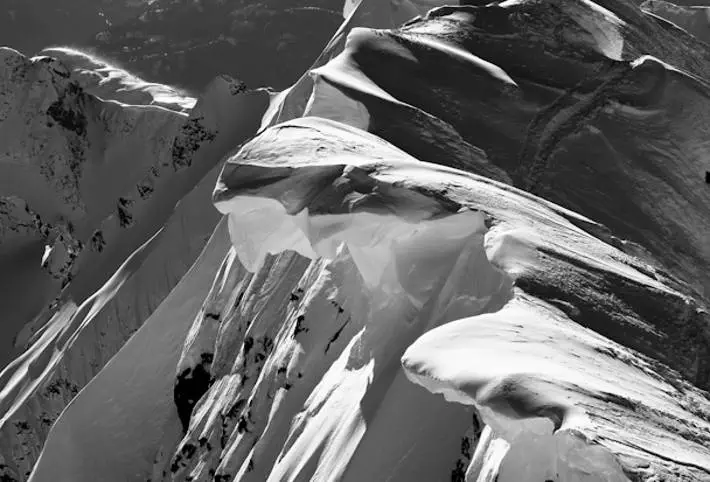One of the recurring themes in British Columbian backcountry advisories this season is cornices. These aesthetic but often hazardous snow structures are formed by wind drifting snow onto the downwind side of an obstacle, such as a ridgeline or precipice. Their size can range from windlips a few feet high to the size of small houses, sometimes even larger. Cornices present a hazard for a few reasons; they can be hard to identify from the top of a ridge, they can be very sensitive to triggers such as an explosive (or even the weight of a skier) and the weight of a collapsing cornice can trigger a sizable avalanche. To help keep your backcountry spidey senses tingling, here’s a few facts about cornice hazards.

When to Watch Out
We know that cornices need wind to form, but how much wind exactly? The sweet spot for cornice growth is wind speed between 25 – 40 km/h. Much less than that and it won’t really move enough volume of snow to form, much more than that will move the snow further down the slope creating other hazards such as wind slabs (another lurking danger, check out our post on wind slabs earlier this season). The direction of the wind is also important. In the South Coast of B.C. winds tend to trend from the south west which can create cornice hazards of various size on northern aspects. And yes, those shady north-facing slopes are often the ones with the best snow that we love to ski. But occasional strong arctic flows from the north can also build up cornices above slopes that don’t typically see them.

The other red flag to watch out for is rapid temperature changes. In the spring time, alpine temperatures can start cold early in the morning and warm up significantly throughout the day. When that happens, cornices (and all avalanche prone slopes for that matter) become a lot more unstable.
Take home tip: Keep your eye on the weather and avalanche forecast not just on the morning you head into the backcountry, but up to 48-72 hours before you depart if possible. That way not only get the best idea of trending snowpack, but also how wind and temperature fluctuations are affecting potential triggers like cornices.

Recognizing and Avoiding the Hazard
Cornice hazards are fairly easy to spot from below and from the side, so it should be easy enough to avoid travelling uphill in their potential slide paths. When travelling on a ridge, however, they can be much harder to pinpoint. Remember, cornices form on lee slopes and lee side of terrain features. So if you’re travelling over wind-packed snow, chances are there’s a sizable cornice on the other side of the ridge.
Where things can get dangerous is in stormy or low visibility conditions. You may not be able to see the cornice hazard during your approach and it’s even more difficult to recognize where the solid ground ends and the overhang of snow and ice begins. It was this situation that contributed to the tragic death of five hikers on Mount Harvey near Vancouver in early April, 2017.
Take Home Tip: If you do need to cross a slope with an overhanging natural snow sculpture looming overhead, do so quickly one party member at a time. Cornices can release suddenly with no external trigger. Never trust a cornice to support your weight and always travel safely back from the ridge crest on the windward side of the ridge.

Managing Cornice Hazards
While cornices will inevitably form above slopes that we want to ski, that doesn’t mean we need to avoid those slopes all together. One way to safely inspect an entrance to the slope is to rope up to an anchor point such as a tree, rock outcropping or a T-slot anchor. You can then rappel or have your partner lower you over the edge to test the integrity of the cornice.

Cornices can also be cut using a snow saw, a length of knotted cord or even by stamping down on them with a pair of skis (all while safely roped up, of course). This is an advanced technique that uses the weight of falling cornice debris to test the stability of a slope. Note that cornice cutting requires specific training, so make sure you take a course and have the right skills and equipment.
Take Home Tip: If you can’t see over the edge, assume it’s an unsupported cornice and rope up appropriately, or look for an alternative entrance from the side. Never linger underneath a cornice while skiing. Get to an island of safety where you can spot friend skiing down after you.

With a such a stellar season of snowfall, backcountry skiing will be possible deep into the spring months. But a caveat of that snowfall are the large number (and magnitude) of cornice hazards. Always stay alert, stay up to date on the avalanche forecast and always keep a third eye open on wind and rapid temperature changes.
Ski safe this spring!

